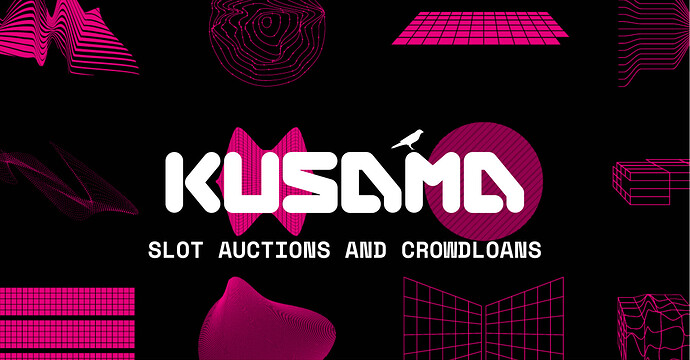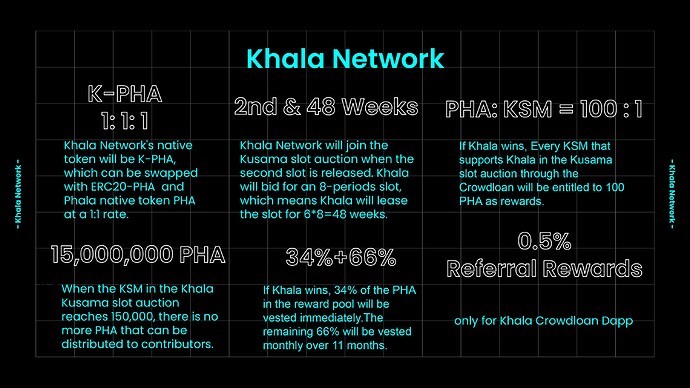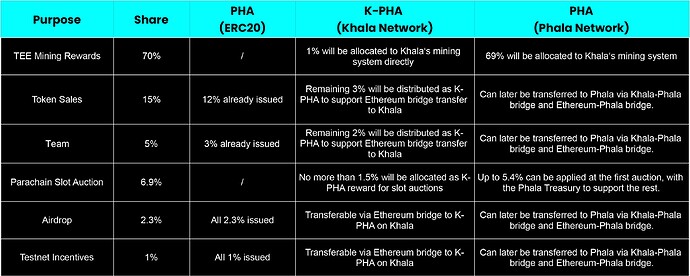 Introducing Khala
Introducing Khala
TL;DR:
- Phala Network will launch pre-mainnet Khala Network on Kusama (mainnet Phala will follow on Polkadot.)
- Khala Network’s native token will be K-PHA, which is PHA on Khala. No new tokens are being created. K-PHA can be swapped with ERC20-PHA (and with PHA on future mainnet) at a 1:1 rate.
- Khala Network will join the Kusama slot auction when the second slot is released. Khala will bid for an 8-period slot, which means Khala will lease the slot for 6 * 8 = 48 weeks.
- Every KSM that supports Khala in the Kusama slot auction through the Crowdloan will be entitled to 100 PHA as rewards (PHA: KSM = 100:1). The fixed reward ratio for the Crowdloan is intended to provide each participant a full 100 PHA per KSM, regardless how many KSM are raised.
- There are 15,000,000 PHA set aside for rewards on Kusama auctions. Based on the above ratio, when the KSM in the Khala Crowdloan reaches 150,000, there is no more PHA that can be distributed to contributors.
- When Khala wins a slot and runs as parachain successfully, 34% of the PHA in the reward pool will be vested to contributors’ addresses immediately. The remaining 66% will be vested monthly over 11 months.
- There is an additional reward available for Referrals. If a Crowdloan participant invites an additional participant who makes an additional contribution, they will each receive an additional reward: an extra 0.5% on the additional contribution.
- Khala will also leverage the on-chain dApp deployed by the Phala team and several top centralized exchanges’ collaboration channels to participate in the Kusama slot auction.
 Kusama Parachain Slot Auctions
Kusama Parachain Slot Auctions
The key to Kusama’s scalable multichain architecture, parachains connect to the network by leasing a slot on the Relay Chain via permissionless auction. As Polkadot’s canary network, Kusama will roll out parachain auctions first for testing and optimization. Parachains will likely be onboarded to Kusama gradually at first to make sure everything is running smoothly, but no promises.
How the Slot Auctions Work
Parachain slot auctions follow a modified candle auction format, where the exact endpoint of the auction is unknown by participants in order to prevent auction sniping (the strategy of bidding at the last moment), leading to more accurate price discovery.
- Teams bid by specifying at least one contiguous range of 1–8 lease periods (each lease period is 6 weeks) and the amount of KSM they are willing to lock up for the duration of the chosen range.
- Open bidding continues for the duration of the auction. Teams can see other bids and increase their bid over time to stay competitive throughout the auction.
- At the end of the auction, the precise moment of the auction’s close is randomly determined by a verifiable random function (VRF).
- The winning parachain is automatically onboarded at the start of the lease. The KSM amount that was bid remains locked for the duration of the lease, after which it can be unlocked.
- Teams can extend their lease by winning another auction before the conclusion of their current slot lease period.
Crowdloan
Some teams may choose to crowdfund their slot lease using Kusama’s built-in crowdloan mechanism, which allows people to contribute by agreeing to lock up their own KSM until the end of the lease. Teams can reward their contributors however they see fit and can structure their crowdloan in various ways, hosting it either natively on Kusama or on a 3rd-party platform.
The typical process for a crowdloan conducted natively on Kusama will look something like this:
- The team creates a crowdloan campaign, setting a maximum of total allowed contributions and a campaign end date (to account for the possibility of losing one or more auctions, a campaign can last for several auctions), and invites their community to participate.
- Crowdloan contributors initiate a special transaction allocating transferable KSM to the campaign’s index (this is different from a normal send transaction, contributors should NOT send KSM to an external account).
- KSM contributions can be submitted throughout the duration of the crowdloan campaign or until an auction is won, up to the maximum amount of contributions set by the parachain team when creating the campaign.
- If there are enough contributions to win an auction, the chain is automatically deployed at the start of the lease, and the full amount of KSM contributed to the campaign index will remain locked for the duration of the lease.
 What Is Khala Network?
What Is Khala Network?
Khala Network is the Phala pre-mainnet on Kusama, as published on the roadmap last year:
- Phala will implement its mainnet on Polkadot, as the parachain to serve enterprise-scale blockchains and DeFi service.
- Khala will implement its mainnet on Kusama, as the parachain to serve creative and growth blockchains and DeFi service.
Why is it Named “Khala?”
The Khala was created in our darkest moment. Only its light was able to bind our people — to give us unity. We are born into it, and when we die, our spirits become one with it.
— — Grand Preserver Rohana

In the popular game series Starcraft, the Khala is the highest principle of Protoss society. To find a way to end all conflicts, the legendary sage Khas meditation on a khaydarin crystal, healing himself and learning how to unify all the Protoss eventually. His psionic philosophy and the ability to share-mind became the Dao of Protoss — Khala.
For us, Khala Network is the Kusama version of Phala Network.
 The Khala Slot Auction
The Khala Slot Auction
Basic rules
- Khala Network will join the Kusama slot auction when the second slot is released. Khala will bid for an 8-period slot, which means Khala will lease the slot for 6 * 8 = 48 weeks.
- The end of each Khala Crowdloan round is dictated by the Kusama Crowdloan rules. If Khala doesn’t win a slot after N rounds, KSM Crowdloaned for Khala Network can be unlocked and returned to contributors’ control immediately, but Khala will keep bidding until a slot is won. If Khala wins, Crowdloaned KSM will be unlocked at the end of the lease period (48 weeks from the auction Khala wins).
- If Khala wins, Every KSM that supports Khala in the Kusama slot auction through the Crowdloan will be entitled to 100 PHA as rewards (PHA: KSM = 100:1). The fixed reward ratio for the Crowdloan is intended to provide each participant a full 100 PHA per KSM, regardless how many KSM are raised.
- There are 15,000,000 PHA set aside for rewards on Kusama auctions. Based on the above ratio, when the KSM in the Khala Kusama slot auction reaches 150,000, there is no more PHA that can be distributed to contributors.

Reward Pool Distribution
- There are 2 primary ways to support Khala: using the Crowdloan Dapp or through centralized organizations (like exchanges);
- Regardless the method, the ratio for the Rewards is the same 100:1.
Referral Rewards (Only for Crowdloan Dapp)
There is an additional reward available for Referrals. If a Crowdloan participant invites an additional participant who makes an additional contribution, they will each receive an additional reward: an extra 0.5% on the additional contribution.
Khala Rewards Vesting
When Khala wins a slot and runs as parachain successfully, 34% of the PHA in the reward pool will be vested to contributors’ addresses immediately. The remaining 66% will be vested monthly over 11 months.
Example:
Alice contributes 200 KSM in the Khala Crowdloan, and invites Bob to participate. Bob contributes 50 KSM in the Khala Crowdloan.
Khala wins at the third-round auction and launches on May 1st, 2021.
Then:
Alice’s reward: (200 KSM * 100) + (50 KSM * 100 * 0.5%) = 20,025 PHA
Bob’s reward: (50 KSM * 100) + (50 KSM * 100 * 0.5%) = 5025 PHA
Alice will receive 20,025 * 0.34 = 6808.5 PHA on May 1, 2021. The remaining 13216.5 PHA will vest into her account linearly over the next 11 months.
Khala Network Token Economic Model

- Phala‘s overall Economic model and total supply are unchanged;
- A portion of the existing PHA in the current token distribution will migrate to Khala Network as K-PHA;
- Additional PHA can come to Khala through the ERC20 — Khala Network bridge. ERC20 PHA holders can decide whether to migrate tokens to K-PHA on Khala;
- When Phala Network goes live as a Polkadot parachain, we will open bridges between Phala and Khala as well as ERC20 — Khala
- The exchange ratios shall be PHA-ERC20:K-PHA: PHA = 1:1:1, preserving the initial supply figure.
Figures below refer to percentages of the initial PHA supply.

 Bridges Contract
Bridges Contract
ERC20-PHA can be swapped to K-PHA on Khala Network at a 1:1 ratio through the Khala-Ethereum bridge. This function will be available as soon as the Khala Network is live.
How to Transfer ERC20-PHA to K-PHA?
- Users send PHA to an ERC20 bridge contract address along with a Khala deposit address;
- The ERC20 contract freezes the ERC20-PHA;
- Khala Network sends K-PHA to the indicated address when it receives the cross-chain frozen message.
How to Transfer K-PHA to ERC20-PHA?
- Users send K-PHA to the Khala bridge address along with an Ethereum deposit address;
- Khala network freezes the K-PHA;
- The ERC20 contract sends ERC20-PHA to the indicated address when it receives the cross-chain frozen message.
 TEE Mining
TEE Mining
- TEE mining reward on Khala is up to 10,000,000 K-PHA;
- The Khala TEE CPU Staking Requirements, Daily Reward Amounts, and Halving Cycle will be released soon;
- Other design aspects are the same as the existing Phala Token Economics Model.
 Gatekeepers
Gatekeepers
The inflation algorithm will follow the model described in the Phala whitepaper. The intent is to use yield to incentivize a healthy fraction of coin in the system into being staked on Gatekeepers to ensure the safety of the system, while at the same time imposing a cap on inflation.
 Governance
Governance
- When Khala Network is live, we will go through several milestones, including POA → Gatekeeper & TEE mining launch → parliamentary election → moving out sudo;
- The initial governance module will adopt a general Substrate module;
- When TEE mining begins, profits will be collected to the Phala Treasury. Democratic votes on financial committee proposals and public proposals will dictate future distribution.




